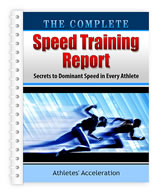Easiest Way to Get Faster
Three. Stroke your arms. This. Look where my fingers are touching as they pass my body. And then the elbow comes up and it's just like I'm not here. Up to where I feel my body is straight, shoulders are straight, and the elbow comes up, and it just catches like that. All right? And this stops here. There's a bio-mechanical principle that the body does automatically if I swing this and stop it and create more force through the ground from my foot into the ground. And this one stops back here. All right? Now as I want to go faster, I'm stroking faster through that range of motion. I'm stopping, but I'm faster through that range of motion. Faster, faster, faster, faster till I can't go any faster. And you hope that's at 60 meters. Then after that, you maintain the stroke, maintain your body position, keep your feet coming down and relax. Don't fight it. And that has a lot to do with technique, maintaining and not decelerating as much, anaerobic conditioning, how conditioned the athlete is. He's got to be able to hold that. The lactic acid's building up. He's got to hold that stroke and keep his feet coming down and stay relaxed and decelerate gracefully. And if he's patient, he'll pass people at the end, right at the end. The last five meters he'll go right past them if he's patient, runs his own race. You got to play with this. Got to think about it. Okay? Put this down. The arms control your tempo and range of motion. Your arms control your tempo, your turn over, and the stride's length if you want to call it that. Is there a particular way you want to hold your hands? You can hold them – as long as you're not robo-copping but as long as all the movement is from the shoulders you will not – yeah. You want them open? You can have them open or you can have them closed, but the longer lever, the easier it is to feel the stroke. When you're here, see, it's harder to feel the amount of punch. But it doesn't make any difference. They still have to open up the arm and stroke regardless if their hand's here. But all of the movement has to come from the shoulders. It can't come like this, like you're punching. It's got to be the range of motion. Now listen to me here. Listen. They have to go through that range of motion faster, not quicker, not bigger. Some kids will say, "Oh, I'm stroking my arms, hey, I'm really going to stroke them." And then they're up in here and they're here. It doesn't work. You've got to stop down and come up in the back. There's a range of motion that fits. The good athletes generally have this. It's the other athletes, in-between athletes, that don't get it. They want to overdo it. You got kids that you tell them one thing, they want to overdo everything. They want to take it to beyond beyond. Just do what I say. Just do this. Don't try to do more. Don't out think me. Just do this, do that range of motion. Coach, come up here. All right, just stroke your arms. Fine, that's right. Open your hands up just for – yeah. All right. Okay, now, control them. Just can't keep mouth open. All right, now stroke them. Let them come down and then up in the back. Keep your wrists straight, don't bend them to the back. Just keep them right there, okay, and spread your fingers out.
Okay, stroke. Stand tall. Straighten up. Just stand up tall. All right, don't let yourself lean forward. Okay. All right, now stroke. That's good. Relax. Now keep stroking faster through that range of motion. Stay relaxed now. Faster, faster, come on. Stroke. Don't tie them up now. You got to keep stroking. Faster and faster, faster. Okay, good. All right, now, I'm going to ask him to do that and then I'm going to ask him to shorten the lever. Okay, go ahead, start stroking. All right, stroke. Now nice and smooth. Staying relaxed, man. You're running that 100. You're relaxed. You're trying to maintain speed. Now shorten the lever and stroke them quick. All right? You lose power. Yeah. Okay. Now, good. When an athlete gets through 60 and he feels slowing down, that's how he reacts – "I'm slowing down. I've got to get quicker" – when he should just stay there and stroke. Not quicker because then you cut your stride off so you don't allow the hips to extend. When you start joining up, they start not extending. They can extend but not as well as if you keep stroking. You can't go any faster after 60. You're not going any faster. All you can do is hold it for as long as possible, and then you're going to end up decelerating if you try to hold it by stroking. Jaw relax and just stroke.
Click Here to Go Back to the
Related Articles: How to Run Faster | Maximum Velocity-Top Speed Running | 3 Rules for Writing Running Workouts | Run Faster | Core Training for Athletes | Sport Coaches | #1 Speed Training Question to Running Faster | Easiest Way to Get Faster
|
|||||
